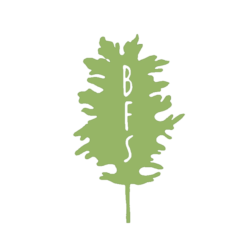Workshop: Bees
Age range: grades 5-9
Time: 1 hour
Materials: Honeycomb, 2 contrasting jars of honey for tasting (light and dark), wooden stir sticks, sunflower seeds, jar of pollen
Depending on number of students, activities 3, 4, and 5 can be set up as rotating stations.
Activity 1: Mini Discussion and Introduction to Bees
Have students share what they already know or think they know about bees by participating in a Think-Pair-Share activity, in which students pair off to discuss and then share their thoughts with the entire group.
Explain that bees have three major interests: pollen, nectar, and reproduction. Note that bees are not out to sting people. Clarify when and why bees sting and review the warning signs before they sting (fly away, buzz louder). Emphasize that stinging is the bee’s last resort.
Activity 2: Observing the Hive
Inform students of proper behavior: calm, relaxed, quiet. Give students a chance to quietly listen to the hum of the bees. Point out the flight path – draw an analogy of a busy doorway and explain the importance of keeping the flight path clear. Explain to students that the beekeeper has two main priorities: (1) to maintain the health of the hive by checking for parasites and other insects and (2) to monitor the growth of the hive by checking in on the amount of eggs that the queen is laying.
Show students a honeycomb and pass it around while encouraging students to smell it. Allow students to observe the comb and take note of what they see. Explain that bees use the comb to store nectar, lay the eggs, feed the larvae, and make honey. Point out the capped honey storage, bee nursery, cells with nectar in them, and larva and drones.
Activity 3: Bee Lesson
After observing the hive, ask students to raise their hand and take turns asking questions and making observations. Use the questions and observations to open up conversation. Explain the three types of honeybees in the colony and their functions (Queen, Drones, Worker bees). Give students an opportunity to observe pollen in a jar. Explain that bees forage by collecting nectar and pollen in their pollen sacs. Explain that different flowers have different-colored pollen and nectar, which affects the color of the honey. Explain how the queen bee is replaced in the hive. Explain how bees communicate.
Activity 4: Honey Tasting
Ask students what their favorite fruit is and explain that without pollinators, those fruits would not exist. Explain that the bee is an incredibly efficient pollinator but is not the only pollinator in the environment. Ask students for examples of different pollinators. Briefly explain pollination and define pollen as the genetic material from the male organ of the flower. Review the three main interests of honeybees (nectar, pollen, and reproduction).
Taste sunflower seeds and explain that honeybees are the primary pollinators for sunflower seed production.
Pass out honey fun fact cards and have students take turn reading a fact aloud.
Ask students if they know what honey is made of and how and why bees make it. Explain that worker bees collect nectar, which they store in their bodies and carry back to the hive where they then regurgitate it. The nectar in the hive becomes concentrated through a process of evaporation and transforms into honey.
Pass out honeycomb tastings to each student. Show students two different types of honey and ask why they might look and taste different. Explain that different flowers have different-colored pollen and nectar, which affects the color and taste of the honey. Explain how honey can be flower specific.
Activity 5: Closing Conversation
Ask students: Why do we have a beehive on the farm? Students again can participate in a Think-Pair-Share activity around the question.
Some possible answers: so we can have honey; to have more pollinators (i.e. more fruit), an educational tool to teach people about bees.

